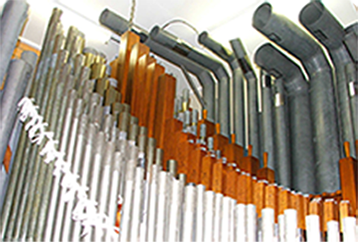Asbury Park Convention Hall
Asbury Park, N.J.
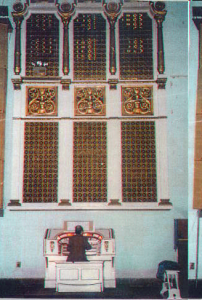
The Late Ashley Miller Plays the Convention Hall Kilgen

Asbury Park Looking North – Paramount Theatre, Left, Grand Arcade, Center, Convention Hall, Right
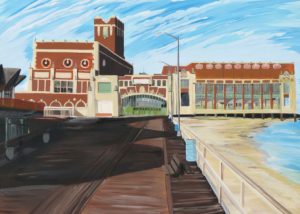
Asbury Park Looking North Along the Boardwalk to the Theatre/Arcade/Convention Hall Complex

Asbury Park Looking North- Closer View of Grand Arcade Entrance
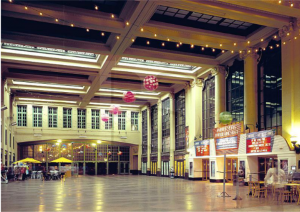
Looking North Inside the Asbury Park Grande Arcade – Convention Hall Entrance on Right
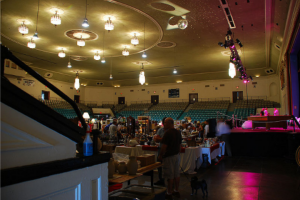
Asbury Park Convention Hall Interior – Stage at Right
When the center floor section is set up with seats, the capacity is 3600.
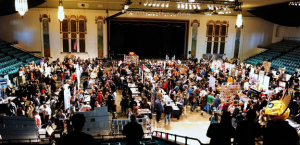
Asbury Park Convention Hall Interior – Viewed toward the Stage
The Convention Hall Kilgen Pipe Organ
Asbury Park Convention Hall was originally designed with the intention of installing a large Wurlitzer for public performance. Architects Warren and Wetmore strategically placed massive grille work into the walls on either side of the hall’s main stage as a façade for the organ chambers. The Great Depression forced the city to abandon the original idea of buying a large Wurlitzer, but according to opus lists, a 2/4 Style C3 Wurlitzer, Opus 2126, was shipped to the hall from the factory on 8/16/30. It did not remain there for long, and may not have been installed. Seven months later on 3/28/31 it moved to the Episcopal Church of the Epiphany, Orange, N.J.
After the closing of the Earl Carroll Theatre on Broadway in New York City in 1931, Asbury Park was able to purchase that theatre’s 3/7 Kilgen Theatre Pipe Organ for the hall. It had been built in 1929 by George Kilgen & Sons of St. Louis. Though considerably smaller than the Wurlitzer for which Convention Hall had been built, the Kilgen managed to sound much larger with the help of the hall’s acoustics.
In the 1930s, Asbury Park created the position of municipal organist. The first, G. Howard Scott, would play free concerts to entertain visitors to the resort’s boardwalk. WCAP would broadcast some of these concerts to its listeners from its studio at the hall. Jim Ryan took over in 1958, performing until the mid-1970s. The final municipal organist was Al Devivo, who performed from then until 1984, when the municipal concerts ceased.
Then Garden State Theatre Organ Society volunteers began refurbishing the instrument and added ten more ranks and a chrysoglott, resulting in an even fuller sound. The console – traditionally in a stationary position underneath the southernmost grille – was made mobile so as to allow performers to play the instrument closer to the audience. GSTOS Crew Chief Russ Sattur dedicated his life to the project, spending practically all his spare time weekends and weekdays, working on the organ. Crew member Jean Scibetta was there with him most of the time. She was responsible for making the umbilical cable that enabled the console to be relocated to the center of the hall for concerts. Since the organ was on a mechanical relay, there were hundreds of wires in that cable. Another person who spent quite a bit of time working on the crew was Bruce Conway.
The organ continued to be played intermittently from 1984 through the early 1990’s, most famously by composer and Radio City Music Hall organist Ashley Miller.
Organist Don Hansen played the Kilgen for the twice a year Convention Hall Gem & Mineral show in the late 1980’s early 1990’s. The show was an all day affair held in the Spring and the Fall by a gentleman who owned a shop in the town of Asbury Park. The show drew folks from far and wide and was quite popular and successful.
For 2 ½ years from approximately 1989 thru 1991, a Summer Concert Series was presented. The series started on the July 4 weekend with concerts being played weekly on Sunday afternoons until the Labor Day weekend. Some of the talented organists who played were Mike Britt, Ralph Ringstad, Jr., Don Hansen, Martin Boehling, Candi Carley-Roth, Wayne Zimmerman, Greg Owen, Ashley Miller and others. Ashley usually played the “Grand Finale” concert on Labor Day weekend. Initially, these events drew perhaps 30 people, but by the time the series ended it was drawing a couple of hundred. There are several retirement apartment houses in the area, and the tenants started making an afternoon of the concert and then a meal at the now closed Howard Johnson restaurant just outside the convention hall building. They were described by one of the artists as a great audience to play for.
At the beginning of one of the Summer Concert seasons there was a horrific storm on the Thursday before the first concert. It blew a hole in the back of the roof of the building and the water found its way down two floors and into the main chamber. Virtually every person in GSTOS that had any kind of technical ability descended on the hall to help Russ get the organ playing, and the Sunday concert went off with Mike Britt at the console and only a few ciphers. The damage caused plaster particles to jam open most of the pipe valves, and thus the main chamber needs a total rebuild. After two or three concerts into the third season, the hall was closed down for asbestos violations and abatement. It is believed that the organ was never played after that. With the fate of the hall left in limbo by Asbury Park’s long-delayed redevelopment plans, further access to the instrument was denied and it has lain dormant for most of the 2000s.
While the hall was closed for renovations, miscreants broke in and tried to steal the huge speakers that were installed on either side of the proscenium arch. The console of the organ had a light plywood cover that protected when not in use. The thieves tried to stand on the cover to reach the speakers, and the cover collapsed doing considerable damage to the left side of the console making it unusable.
After Russ Sattur’s death, GSTOS was last involved with the organ in 2001 with new crew members working on refurbishing and refinishing the badly damaged console (not completed). The numerous management changes at Convention Hall and in the town of Asbury Park, combined with limited GSTOS crew members available, and a key member of the new organ crew being incapacitated for months, resulted in GSTOS losing touch. With the water damage in the main chamber, and the console dismantled, the Kilgen is currently unplayable.
Note:
Wurlitzer Opus lists indicate that a 2/6, Style 160, Opus 417 was installed at the Arcade Theatre, next to Convention Hall on 5/17/21. The fate of that instrument is unknown.
Chamber Layout
From a chamber survey 7/14/00 performed by Paul Jacyk
(The original Kilgen Ranks from the Earl Carroll Theatre had the opus number stamped on the chests.)
| Left | Right |
| Vox Humana I (8′) Salicional (4′) Viol Celeste II (4′) Open Diapason/Diaphone (16′) Tibia Clausa I (16′) Kinura (8′) Flugel Horn (8′) Trumpet (8′) English Post Horn (8′) – TrivoChimes Glockenspiel/Orchestra Bells Xylophone Marimba Salicional/VC II are off same magnets |
Vox Humana II (8′) Viol D’ Orchestre (8′) Viol Celeste I (4′) Flute/Bourdon (16′) Diapason (8′) Tibia Clausa II (4′) Tuba I (16′) Tuba II (8′) Voicer David Arthur 10″Crysoglott TrapsIn storage: 16′ wooden string (CCC – CC) |
The Diaphone is from a 1921 3/15 Kimball in the Arcadia Theatre (510 N. Market Street Wilmington, DE) which seated
1305. The Arcadia was listed all during the 1920’s, up until the 1960’s in Film Daily Yearbooks.
Note:
It is our understanding that when GSTOS added the 10 ranks plus Crysoglott the console stop tabs were not respecified. The additional ranks were added to existing stop tabs, each of these tabs now controlling two ranks at once.
The Organ As Installed at Convention Hall in 1931
The Kilgen came from the Earl Carroll Theatre (Broadway), New York as a 3/6 Kilgen Wonder Organ, 1929, Opus 4258 Style U016X (A 1926 Kilgen list price sheet listed the price as $23,400.00)
In 1931 other Kilgen additions were made as part of the reinstallation at Asbury Park Convention Hall.
| Opus | Size | |
| 4610 | 3/7 | Parts |
| 4613 | 3/7 | Generator |
| 4619 | 3/7 | Swell shades |
| 4646 | 3/7 | Parts |
| 4717 | 3/7 | Rebuild Relay |
The Six Ranks, Tuned Percussions, Traps and Toys That Came from the Earl Carroll Theatre:
16′ Flute 1-24, #1 pedal bourdon scale; 25-97, #1 melodia scale
16′ Tuba 1-12, 10″ scale; 13-85
8′ String 1-85, 65 scale
8′ Tibia Clausa 1-73, #2 scale
8′ Vox Humana 1-73, regular scale
8′ Kinura 1-61
37 note Marimba
37 note Xylophone
5 chimes
tamborine
castanets
tom tom
siren
birds
sleigh bells
37 note glockenspiel/orchestra bells
pedal and accompaniment traps
Console has 2nd touch
Console Disassembly & Move to Organ Work Room
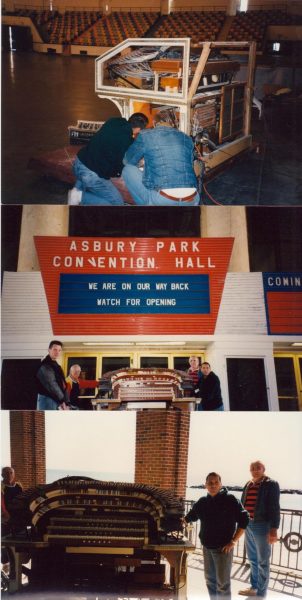
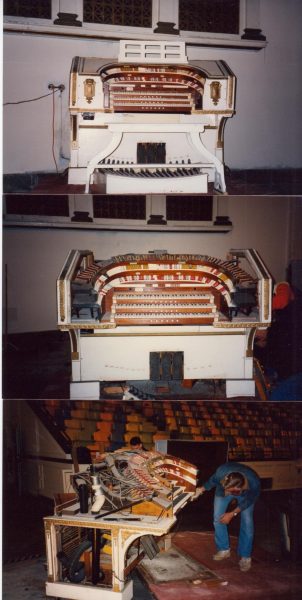
Photos of July, 2001 Console Refinishing

A great view from the organ workroom.
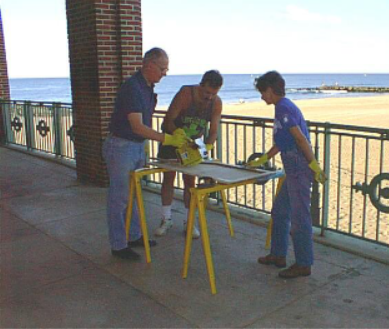
Stripping 5 layers of old paint off of console panels.

GSTOS members working on the organ.
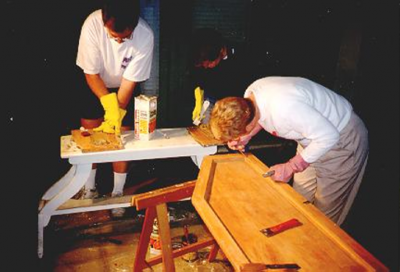
Beautiful wood under the paint.






